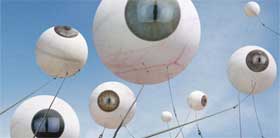 The bad thing about seeing so many festivals and exhibitions is that i turned into that old lady who’s constantly whinging and moaning about the amount of dull or downright crap interactive installations she gets to see. The good side of it though is that whenever i happen to find a really good work, i appreciate it much more than i would have when i was young and fresh to this new media art world.
The bad thing about seeing so many festivals and exhibitions is that i turned into that old lady who’s constantly whinging and moaning about the amount of dull or downright crap interactive installations she gets to see. The good side of it though is that whenever i happen to find a really good work, i appreciate it much more than i would have when i was young and fresh to this new media art world.
Yesterday, bliss! I got to play with two such works as the lovely Carlo Vilma was giving me a tour around Les Yeux Ouverts at the Triennale in Milan. The exhibition space has recently invited Fabrica (the Benetton research centre on communication) to mount the show which the Centre Pompidou presented in Paris last Winter.
I had read about the first interactive work several times in the past but never actually got how fun and clever it is until i tested it. Juan Ospina‘s Flipbook! Deluxe uses a custom-built software application to enable anyone to realize animated clips out of simple line drawings. You create 10 pictures one by one, save them as individual frames and play them back sequentially as an animation.
When you have finished, you can save the film and it will be displayed online or emailed to friends. I could post a link to my awful animation but you might prefer to have a look at something better.
Flipbook! is also exhibited at the Ars Electronica Museum of the Future in Linz.
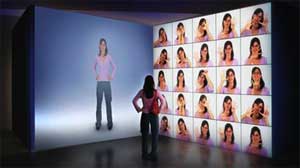 The second installation i really digged is We are the time. We are the famous, by Andy Cameron, David McDougall, Joel Gethin Lewis, Oriol Ferrer Mesià and Hansi Raber. Description: Visitors are confronted by a diptych of two real time images of themselves. One image slows down and blurs time as if it were a photo being developed; the other image fragments time into a sequence of frozen moments, like a strip of cinematic celluloid which appears to move across the wall. On one wall the spectator is encouraged to remain still in order to see his or her image reflected clearly, while on the other one he or she has to move in order to animate the sequence.
The second installation i really digged is We are the time. We are the famous, by Andy Cameron, David McDougall, Joel Gethin Lewis, Oriol Ferrer Mesià and Hansi Raber. Description: Visitors are confronted by a diptych of two real time images of themselves. One image slows down and blurs time as if it were a photo being developed; the other image fragments time into a sequence of frozen moments, like a strip of cinematic celluloid which appears to move across the wall. On one wall the spectator is encouraged to remain still in order to see his or her image reflected clearly, while on the other one he or she has to move in order to animate the sequence.
The still image is in reality a moving image, representing a length of time in motion, while the motion sequence is formed by a series of static moments in time. Time can be seen in two contradictory ways at the same moment. The title of the installation is taken from a poem by Jorge Luis Borges (funny how you never seem to go wrong when refering to Borges.)
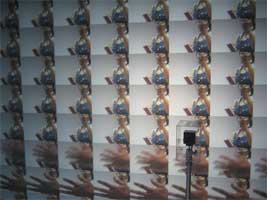
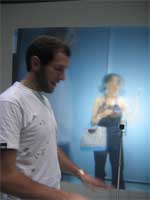
Several reasons why i loved that work. The first one is that the piece doesn’t need any explanation label. You enter the space and quickly discover how it works. Second reason is that it resisted well to my slight attention deificit disorder. I’ve learnt to be polite and pretend i’m interested in what i see in galleries but most of the interactive installations don’t get my attention for more than half a minute. WATTWATF was awesome enough to keep me immersed for much much longer and i actually came back to the installation three time during my visit. It fills you with a sense of beauty, reacts immediately and elegantly to visitors gestures and playing with your own image is obviously irresistible.
Not interactive but worth a mention:
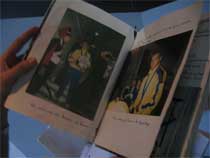
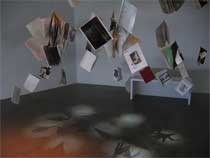
For COLORS Notebook, Fabrica collaborated with Reporters Without Borders and sent blank 30 000 notebooks to people whose voice is never heard: Chinese prisoners, South African children, Canadian priests, astronauts, disabled persons, artists and ordinary people the chance to express themselves without filters or censure. Over 1,000 copies returned to Fabrica, they are covered with words, drawings, paintings, collage, etc. COLORS Notebook is a tribute to a free press and freedom of expression. Some were really gorgeous.
I See, a photo exploration into the current trends of historical, cultural, artistic, social and economic development. Six photographers from Fabrica each picked up a story to represent one of the world’s six main geographic areas: North America, South America, East, Far East, Africa and Europe. I liked the Oil Will Never End series by Lorenzo Vitturi who went to Azerbaijan to document the depletion of oil resources in the region.
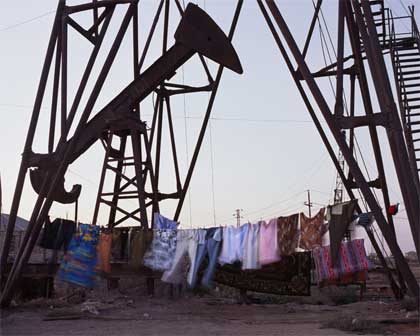
Farbica’s Industrial Design section seems to have some really good projects and objects. Wish i’d hear more about them.
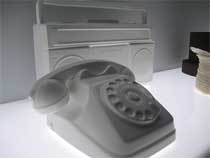
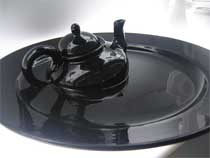
Here’s my Flickr set and Oriol’s images.
More from Fabrica: Interview of Andy Cameron; Tuned Stairs; Your Pictures, Your Politics.
